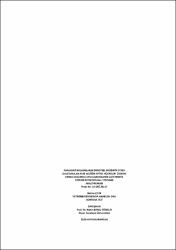| dc.contributor.advisor | Bayşu Sözbilir, Nalan | |
| dc.contributor.author | Çelik, Naime | |
| dc.date.accessioned | 2020-07-10T10:48:19Z | |
| dc.date.available | 2020-07-10T10:48:19Z | |
| dc.date.issued | 22.06.2020 | en_US |
| dc.date.submitted | 2020-05-22 | |
| dc.identifier.uri | https://hdl.handle.net/11630/8390 | |
| dc.description.abstract | Parakuat (PQ) yüksek toksisiteye sahip, kuarterner nitrojen bir herbisittir. Fiyatının ucuzluğu, hızlı etki göstermesi ve çevresel karakteristikleri sayesinde dünyada kullanımı yaygındır. Kazayla veya bilerek gerçekleşen parakuat maruziyeti sonrası etkilenen ana hedef organ akciğerlerdir. Parakuat toksisitesinde reaktif oksijen türlerinin oluşumunun indüklenmesi önemli yer tutar. Bu sebeple, indüklenen reaktif oksijen türleri oluşumuna karşı antioksidanların kullanımı alternatif bir tedavi yöntemi olarak görülmektedir.
Kafeik asit fenetil ester (KAFE) bazı bitkilerde bulunan aynı zamanda bal arıları tarafından üretilen propolisin aktif bileşenlerinden biri olan bir polifenoldür. KAFE, enfeksiyon, oksidatif stres, inflamasyon, kanser, diyabet, nörodejenerasyon, anksiyeteye karşı etkili bir moleküldür.
Bu tez çalışmasında, A549 akciğer epitel hücrelerinde parakuat ile oluşturulan oksidatif streste kafeik asit fenetil esterin etkisini belirlemek amacıyla hücre canlılık testi (MTT), toplam oksidan kapasite (TOK) analizi, toplam antioksidan kapasite (TAK) tayini ve oksidatif stres indeksi (OSİ) hesaplaması yapıldı. Bu amaçla A549 hücre hatlarına 24 saat süresince 400 M parakuat ve 1; 2,5 ve 5 g/ml KAFE uygulandı. Uygulama sonunda yapılan analizlerde parakuatın hücre canlılığını önemli derecede azalttığı, TOK değerlerini artırdığı ve TAK değerlerini ise düşürdüğü belirlendi. Parakuatla beraber KAFE’nin 1 g/ml ve 2, 5 g/ml dozlarının uygulandığı hücre gruplarında hücre canlılıklarının yalnız parakuat uygulanan gruplara göre yükseldiği, 5 g/ml KAFE uygulamasının ise hücre canlılığı üzerinde iyileştirici etkisinin olmadığı saptandı. KAFE’nin 2, 5 g/ml dozda uygulandığı grupta TOK değerleri PQ grubuna göre düşük bulunmuş, fakat istatistiksel olarak sınırda anlamlılık düzeyinde kalmıştır. Parakuat grubunda azalan TAK değerleri 2, 5 g/ml KAFE uygulamasıyla belirgin şekilde artış gösterirken, 5 g/ml KAFE uygulaması TAK değerlerini kontrol grubuna kıyasla düşürmüştür. 1 g/ml KAFE verilen grupta ise TAK değerleri PQ grubuna yüksektir fakat istatistiksel olarak sınırda anlamlılık düzeyinde bir fark bulunmuştur. OSI değerleri PQ ve PQ+5 g/ml KAFE gruplarında kontrol grubuna göre yüksek, PQ+2,5 g/ml CAFE grubunda ise PQ grubuna göre düşük bulunmuştur.
Bu bulgulardan hareketle, kafeik asit fenetil esterin doza bağımlı olarak, parakuatın indüklediği oksidatif stres hasarına karşı koruyucu veya tedavi edici özelliğe sahip olduğu söylenebilir. | en_US |
| dc.description.abstract | Paraquat (PQ) is a high toxic, quarternary nitrogen herbicide. It is widely used in the world due to its low price, rapid effect and safe. The main target organs affected by accidental or intentional PQ exposure are the lungs. In PQ toxicity, induction of reactive oxygen species takes an important place. Therefore, the use of antioxidants against the formation of induced reactive oxygen species is seen as an alternative treatment method.Caffeicacidphenethyl ester (CAPE) is a polyphenol found in some plants, which is also one of the active components of propolis produced by honeybees. CAPE is an effective molecule against infection, oxidative stress, inflammation, cancer, diabetes, neurodegeneration, and anxiety.
In this thesis study, cell viability test (MTT), total oxidant capacity (TOC) analysis, total antioxidant capacity (TAC) determination and oxidative stress index (OSI) were calculated in order to determine the effect of caffeic acid phenethyl ester on oxidative stress induced by PQ in A549 lung epithelial cells. For this purpose, 400 M paraquat and 1; 2, 5 and 5 g/ml CAPE were applied to A549 cell lines for 24 hours. At the end of the application, it was determined that PQ significantly decreased cell viability, increased TOC values and decreased TAC values. It was found that cell viability was increased in the groups of 1 g and 2, 5g/ml of CAPE together with paraquat compared to the groups treated with paraquat alone, whereas 5 g/ml CAPE had no curative effect on cell viability. TOC values were found to be lower in CAPE group compared to PQ group, but remained a slighty statistical difference. In the PQ group, decreasing TAC values increased significantly with 2, 5g/ml CAPE application, while 5 g/ml CAPE application reduced TAC values compared to the control group. In the 1 g/ml CAPE group, the TAC values were higher than the PQ group but showed a slighty statistical difference. OSI values were higher in the PQ and PQ + 5 g/ml CAPE groups than in the control group and lower in the PQ + 2.5 g/ml CAPE group than the PQ group.
Based on these findings, it can be said that caffeic acid phenethyl ester is dose-dependent and has protective or therapeutic properties against paraquat induced oxidative stress damage. | en_US |
| dc.description.sponsorship | Bu Tez Afyon Kocatepe Üniversitesi Bilimsel Araştırma Projeleri Koordinasyon
Birimi tarafından 16.SAĞ.BİL.07 proje numarası ile desteklenmiştir. | en_US |
| dc.language.iso | tur | en_US |
| dc.publisher | Afyon Kocatepe Üniversitesi, Sağlık Bilimleri Enstitüsü | en_US |
| dc.rights | info:eu-repo/semantics/openAccess | en_US |
| dc.subject | A549 | en_US |
| dc.subject | Antioksidan | en_US |
| dc.subject | Kafeik Asit Fenetil Ester | en_US |
| dc.subject | Oksidatif Stres | en_US |
| dc.subject | Parakuat | en_US |
| dc.title | Parakuat kullanılarak deneysel oksidatif stres oluşturulan a549 akciğer epitel hücreleri üzerine farklı dozlarda uygulanan kafeik asit fenetil esterin biyokimyasal etkisinin araştırılması | en_US |
| dc.title.alternative | Investigation of dose dependent biochemical effect of caffeic acid phenethyl ester on experimental oxidative stress generated by using paraquat in a549 lung epithelial cell line | en_US |
| dc.type | doctoralThesis | en_US |
| dc.department | Sağlık Bilimleri Enstitüsü | en_US |
| dc.authorid | 0000-0001-9814-0359 | en_US |
| dc.relation.publicationcategory | Tez | en_US |



















